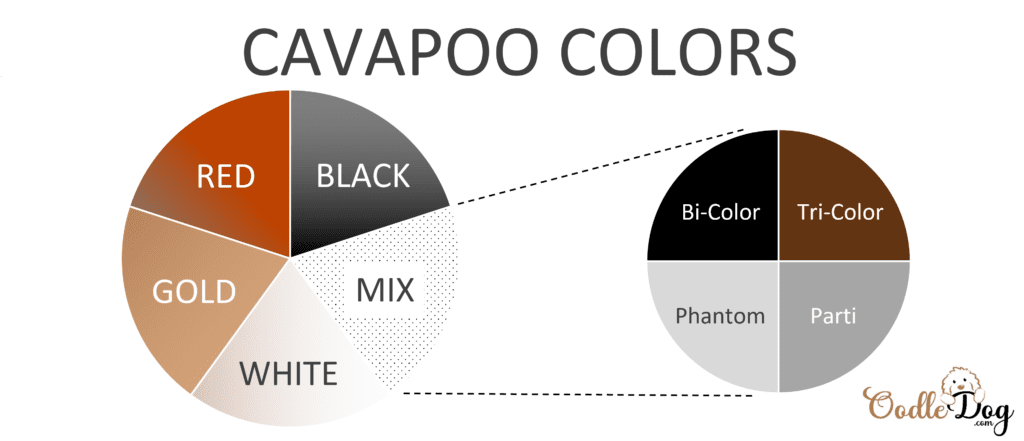When it comes to choosing a Cavapoo one of the things which surprise many would-be owners is just how many different colors they come in. Being a blend of Poodle and Cavalier King Charles Spaniel means Cavapoos come in a host of colors allowing owners to get quite a wide range of choice.
There are five main groups of colors that Cavapoos come in: black, red, gold, white and mixed. Within each of these five groups there are a range of variations which include cream, tan, ruby, apricot, blue, brown, chocolate, grey and silver. There are also blended colors including bi-color and tri-color Cavapoos.
So, what can you expect when you buy a Cavapoo of a particular color, and what exactly do bi-color and tri-color Cavapoos look like? We’ve assembled some great photos and great facts so you can see the wide range of Cavapoos and, if you’re looking to get your own, make a great choice.
Why So Many Colors?
There are five core groups of colors that Cavapoos come in, including:
- Black
- Red
- Gold
- White
- Mix
Within the mix range you can have bi-color, tri-color, parti and phantom coloring. That’s a lot of colors! So why so many?
The range of colors is based on the Cavapoo parents. The American Kennel Club lists the Cavalier King Charles Spaniel as having four standard colors while the Poodle has 11 standard colors. Mix these together and we get lots of variations for the Cavapoo. Add in non-standard colors from the parents and we have almost a complete color wheel going on!

That said, not all colors are common, and not all are in demand either. We will explore each of these colors in more detail, provide you with pictures of each of the color options, as well as outline some of the benefits and advantages of some colors over others. Settle in for a multi-colored Cavapoo extravaganza!
The Most Popular of Colors
Let’s start by covering the most popular of the Cavapoo colors. While we call these ‘most popular’ that really only means that these are the colors most in demand. Owners each have their own taste and these may not be for you.
A recent review of puppies for sale at puppyspot.com showed the following:
| Color | Percentage |
| Red | 53% |
| Bi-Color | 24% |
| Gold | 10% |
| Tri-Color | 8% |
| Black | 5% |
| White | 0% |
By far and away the most listed Cavapoo was Red colored, which included a range of different hues. Bi-colored Cavapoos were also popular with Black and White, Black and Tan and Blenheim colored Cavapoos common.
Blenheim puppies are a blend of white and apricot with the white the base color, and apricot around the eyes or ears of the dog. Blenheim is named in honor of John Churchill, the 1st Duke of Malborough (1650 – 1722) in England, who bred this particular color of Cavalier to assist in hunting.
The listings included Blue Merle. This is a color which is characterized by mottled pattern of color, usually with a black base coat and color patches across the body. Merles can also have different color eyes which makes them look exotic and very cute! Blue Merle is the rarest of colors and comes about through a complex combination of genes.
Red Cavapoos
Red Cavapoos are the most popular of colors and are very common. Often called Ruby colored, they have a beautiful coat with reddish tinges.
Red Cavapoos can range from solid dark red color through to light reds. It’s common they have white patches on their chest.
Red colored Cavapoos are bred from red Poodles crossed with Ruby colored Cavalier King Charles Spaniels.
Gold Cavapoos
Gold Cavapoos are a cross section of a LOT of different colors so labelling with a single term is no easy feat.
Gold Cavapoos include tan, cream, apricot, peach and other varieties. It’s common to have white patches against the base color, such as on the chest, neck, feet and forehead.
White Cavapoos
Solid white Cavapoos are beautiful, but incredibly rare. There were no pure white Cavapoos for sale at the time we researched.
White Cavapoos come from pure white Poodles bred with Blenheim Cavalier King Charles Spaniel, and even in this case most of the puppies will not be pure white.
Most ‘white’ Cavapoos you will see for sale are actually a bi-color Cavapoo with white as its base coat.
Black Cavapoos
Black Cavapoos are a popular but rare color. Black coloring is a recessive gene in Cavapoos. While it is common for Poodles to be black, it is rarer for Cavaliers. Most ‘black’ Cavapoos are actually a combination of black and other colors.
Bi-Colored Cavapoos
A bi-colored Cavapoo is one which has two colors. These color combinations can vary and include red with white areas, gold with white areas, black with white areas, and many more besides.
Chocolate Cavapoos are a good example of a bi-color. They usually have rich and dark brown with white on their face, chest and paws. Solid chocolate colors are rare.
Sable Cavapoos are a rare form of bi-color Cavapoo that are extremely popular. Sable Cavapoos usually have a rich base color, such as tan, and their hair tips are black. While very much in demand, Sable Cavapoos are very likely to fade in color (see our article on Cavapoo color fade here for more information on the dreaded ‘fading gene’).
Tri-Colored Cavapoos
Much like bi-colored Cavapoos, tri-colored Cavapoos are a mix of three different colors. Typically these colors are black, white and gold/tan. But there is no fixed pattern or coloring, and tri-colored cavapoos can come in a range of unique combinations.
Parti
The term Parti comes from the Poodle side of the Cavapoo’s family tree. A Parti colored dog is one where greater than 50% of its base coat is white, and it has another color somewhere on its body. This is distinct from bi-color where there are two colors and the dominant color can be any, not only white.
Parti coloring is caused by a gene called Microphthalmia-Associated Transcription Factor (MATF) which regulates the development of cells that produce melanin and a cell that forms part of the eye’s retina called Retinal Pigment Epithelium (RPE). As it is genetic, two Parti colored dogs will produce Parti offspring.
Phantom
Phantom coloring is a subset of Parti. The term originates from the ‘phantom poodle’ which is a rare coloring of Poodle.
Like Parti Cavapoos, Phantom’s are easily confused with bi-color and tri-color Cavapoos but are unique as they come with distinctive markings in specific places. They tend to have a black or dark brown dominant base color and lighter markings around the mouth and nose (muzzle) and eyes. Generally, the markings are similar to those found on a Doberman Pinscher.

